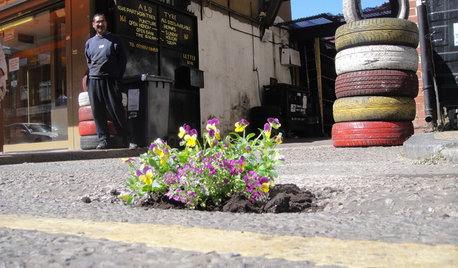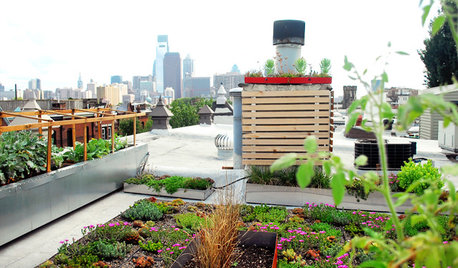Guerrilla gardening
victoriannoire
14 years ago
Related Stories

FUN HOUZZGardening Happiness Found ... in Potholes
Imperfections in roads and sidewalks become miniature works of art — and unlikely sources of joy — at the hands of a London gardener
Full Story
GARDENING GUIDESVegetables and Flowers Mix in Beautiful Edible Gardens
Ornamentals, meet your edible garden mates. We know you'll get along just beautifully
Full Story
GARDENING GUIDESUnleash Your Guerilla Gardener
Toss some seed bombs around the yard for easy, beneficial plantings
Full Story
LANDSCAPE DESIGNGardening for Happy Kids
Foster creativity, self-esteem and more by designing your landscape with a sense of discovery
Full Story
FARM YOUR YARDHow to Farm Your Parking Strip
Get an up-close look at a thriving street-side edible garden, one of many sprouting up in Seattle
Full Story
HOME INNOVATIONSNow Approaching the Emerald City
Urbanites are spraying moss graffiti on walls and covering roofs in plants — and city regulators and designers are supporting the cause
Full Story
HOUSEKEEPINGA Cleaning Routine for Your First Home
With basic supplies and room-by-room checklists, you can get into the housekeeping habit
Full Story
EVENTSExplore L.A.’s Creative Side at Los Angeles Design Festival 2015
L.A.’s flourishing design scene is being celebrated during more than two weeks of events starting May 28
Full Story
BATHROOM DESIGNDesign an Easy-Clean Bathroom
These ingenious strategies and sleek designs for the sink, tub, shower and toilet help your bathroom practically clean itself
Full Story
MY HOUZZMy Houzz: Attention to Detail Revives a Century-Old Louisville Home
After 13 years of wishful thinking, a couple complete a 5-year renovation in their historic Highlands neighborhood
Full Story







plantslayer
pepperdude
Related Professionals
Carlisle Landscape Architects & Landscape Designers · Jennings Landscape Architects & Landscape Designers · Marco Island Landscape Architects & Landscape Designers · Richmond Heights Landscape Architects & Landscape Designers · Sahuarita Landscape Architects & Landscape Designers · Concord Landscape Contractors · Marlborough Landscape Contractors · Parkland Landscape Contractors · Ramsey Landscape Contractors · Shaker Heights Landscape Contractors · Corona Fence Contractors · Folsom Fence Contractors · Mount Pleasant Fence Contractors · San Mateo Fence Contractors · Slidell Fence Contractorshemnancy
idaho_gardener
Embothrium
hemnancy
Embothrium
hemnancy
larry_gene
victoriannoireOriginal Author
phil_m
victoriannoireOriginal Author
yami_mcmoots
victoriannoireOriginal Author
hallerlake
blameitontherain
Embothrium
larry_gene
dancinglemons
Embothrium
victoriannoireOriginal Author
victoriannoireOriginal Author
lucretia1
larry_gene
Embothrium
hemnancy
victoriannoireOriginal Author